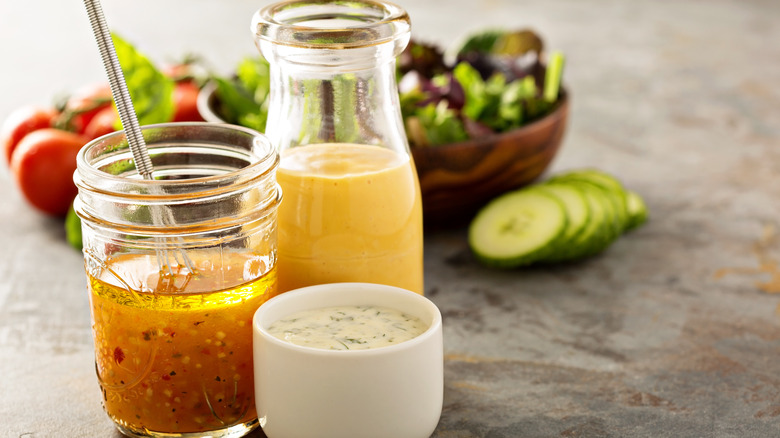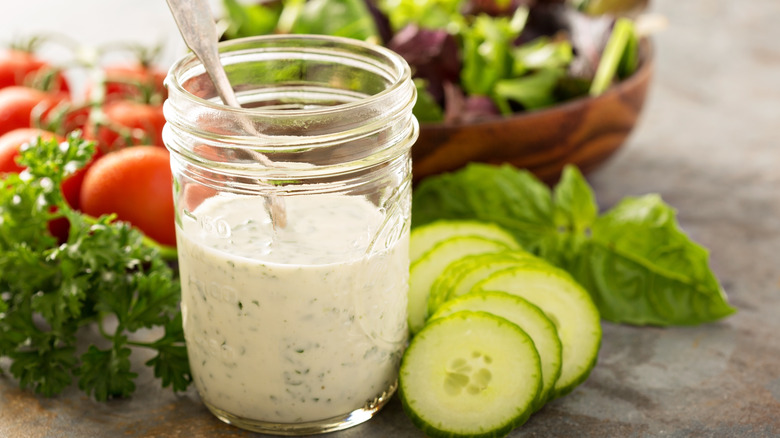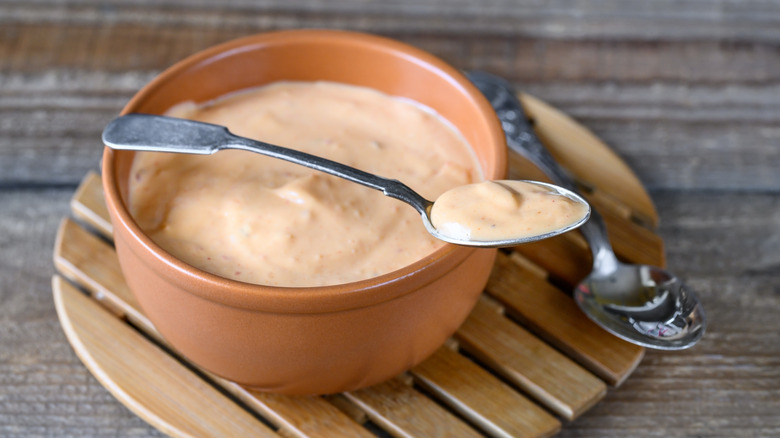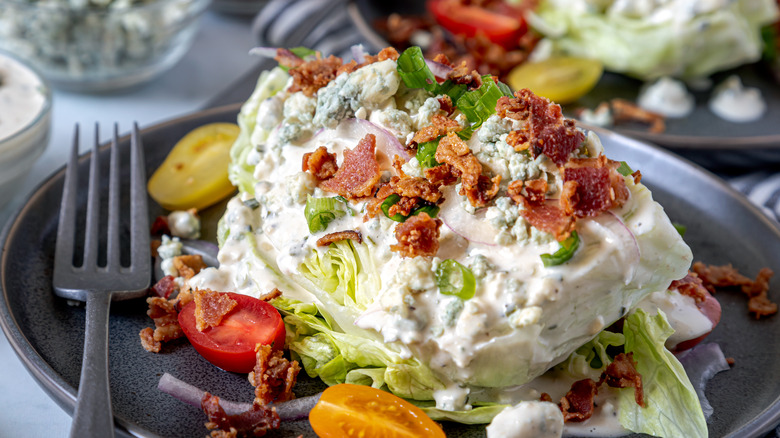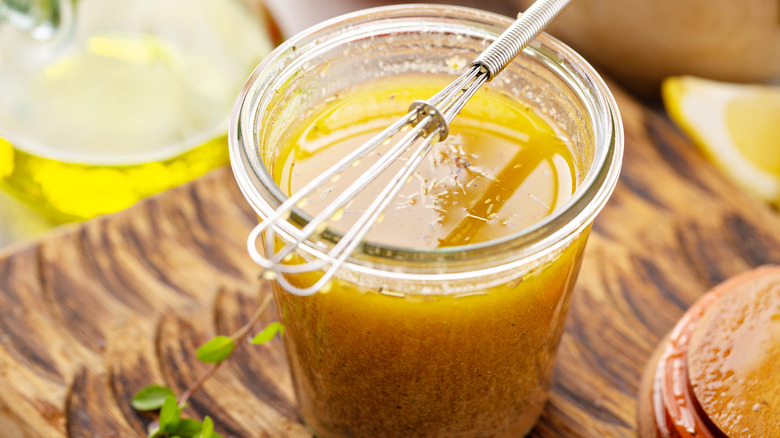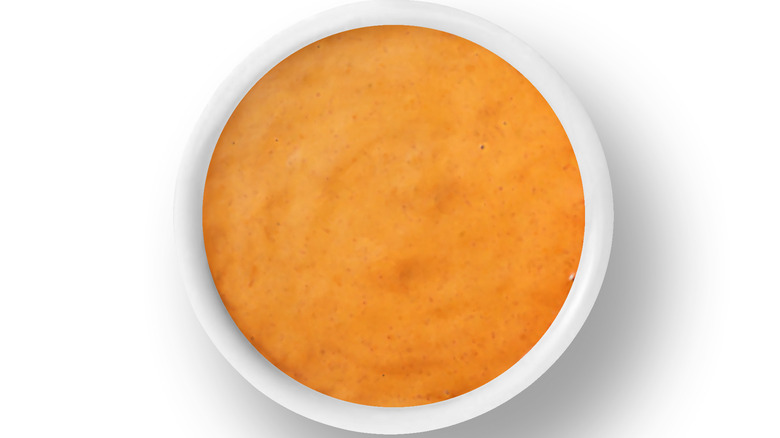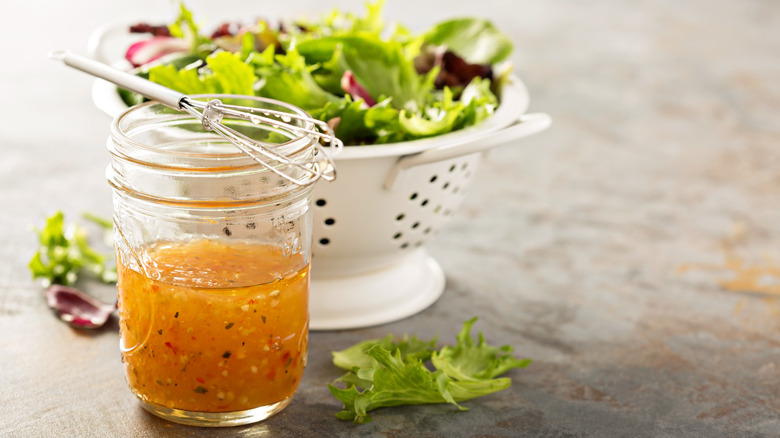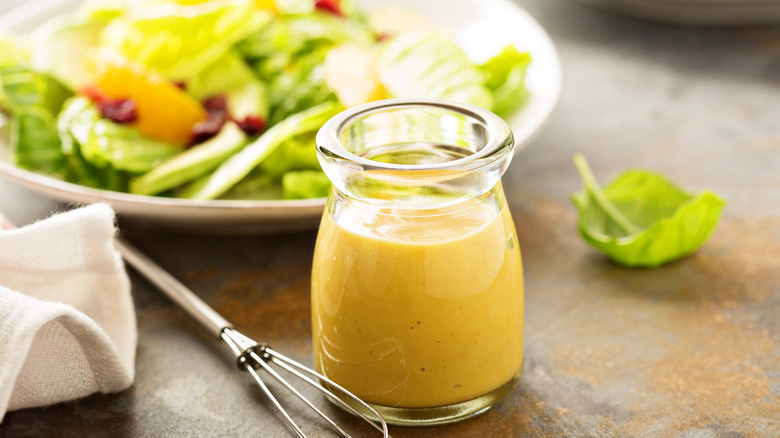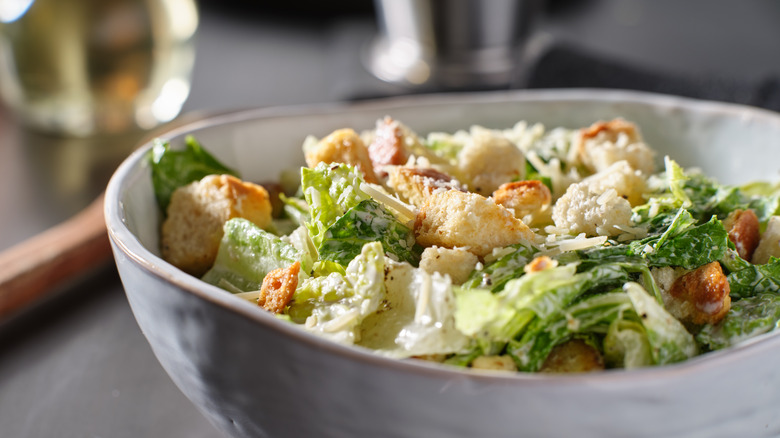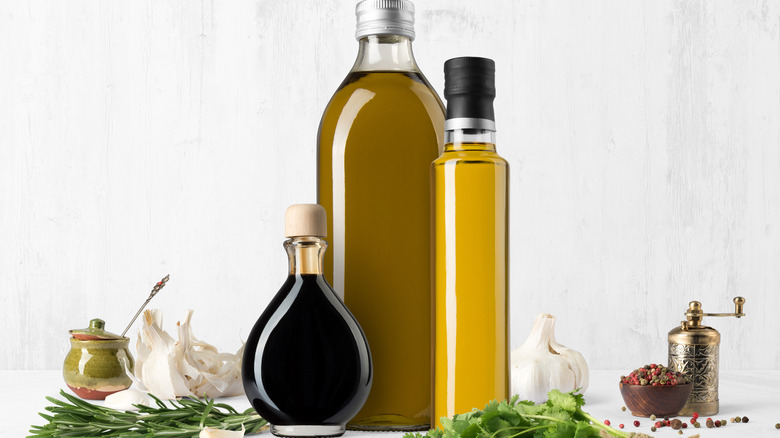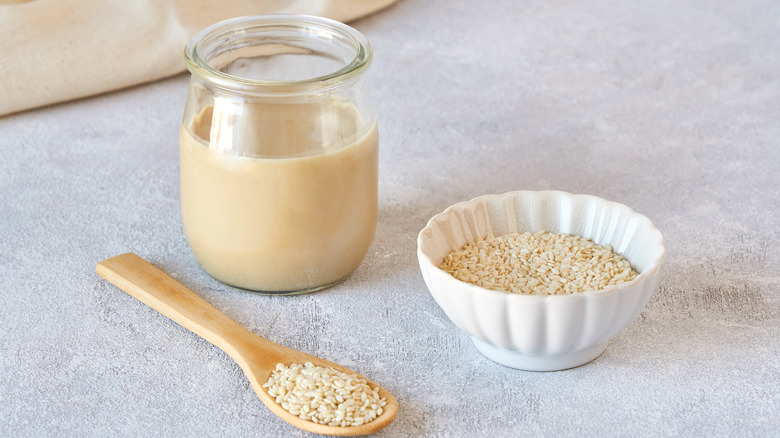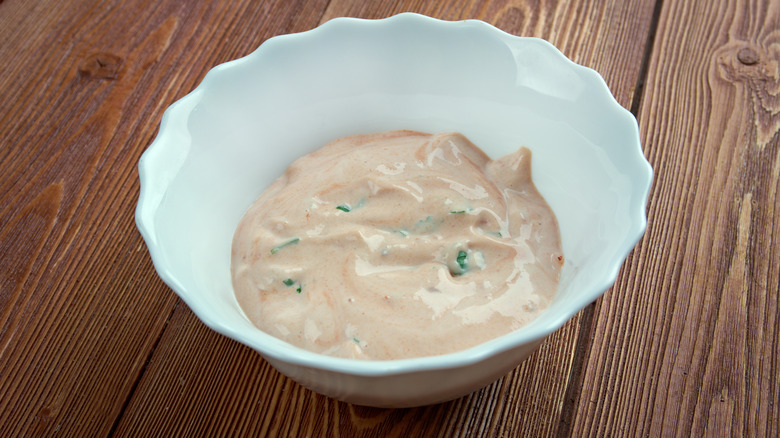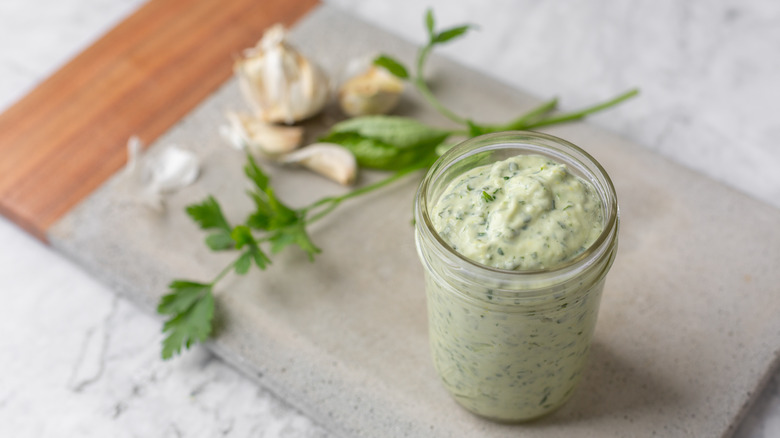12 Types Of Salad Dressing Explained
A fresh salad is always in season. Even before the world was conscious of calories and vitamins, people incorporated a blend of raw vegetables into their diets. Early civilizations prepared wild greens tossed with oil, and European royals dug into massive salad bowls at their elegant buffet tables (via The Association for Dressings and Sauces).
At the beginning of the 20th century, as refrigeration became available to the American household, salad began gaining popularity. With a new way to keep lettuce fresh, consumers began adding more greens and other cold veggies to their plates. And as the taste for salads grew, so did the need to spruce them up with added fat and flavor, creating the demand for dressing.
American grocery stores offer shelves stocked with different salad dressings, from the beloved classics to fat-free options and curious culinary combinations like raspberry bacon. Beyond salads, dressings show up in a variety of other eats including dips, sandwich spreads, marinades, and casseroles. For an in-depth look at some of your favorite salad dressings, keep reading!
Ranch
The most popular dressing in the U.S. (via Food Network) is used on more than just salad. Ranch is an ideal dipping sauce for chicken wings, pizza, and fries. The zesty dressing is also notably the inspiration for a popular variety of Doritos. Ranch's unique flavor comes from a blend of buttermilk, mayo, sour cream, and herbs. The patented blend adds the perfect amount of flavorful fat to your greens.
Ranch dressing hit the scene at the perfect moment, post-World War II, when the health craze hit California. At the time, more and more people were interested in eating salads for a healthy lifestyle. According to The New York Times, plumber Steve Henson came up with the idea for the dressing in the 1950s. His creamy, peppery creation was such a hit with friends, family, and colleagues, that he started to make it and sell it from his ranch called Hidden Valley.
When the Clorox company bought the Hidden Valley brand in 1972, they tweaked the ranch dressing formula and eventually created a version that replaced the buttermilk with a form of dried butter, giving it a longer shelf life (via Slate). With the buttermilk gone, the dressing was bottled up and made its way into grocery stores all over the country, and American consumers never looked back.
Thousand Island
There is no doubt that Thousand Island borrowed its name from a chain of islands located off the northeast United States near the Canadian border. But how exactly the dressing came to be is up for debate. According to NPR, there are two origin stories of this well-known salad addition. One credits the dressing's creation to Sophia Lelonde, who, along with her husband George, owned The Thousand Islands Inn restaurant in Clayton, New York. The other suggests that the chef of the owner of the famous Waldorf-Astoria hotel improvised the dressing during a summer trip to the islands. As with most legends, it's probably a combination of the two stories, especially considering a friend of Lelonde's was also a friend of the chefs.
Regardless of its origin, today, Thousand Island is a popular dressing for salad and beyond. This creative combo of mayonnaise, ketchup, and assorted seasonings is now a common burger topper. (It should be noted that though it was once thought to be the sauce on McDonald's Big Mac, the chain insists that is not the case.)
Blue cheese
The standard blue cheese dressing recipe combines chunky pieces of blue cheese, mayonnaise, yogurt or sour cream, and parsley. The mayonnaise and yogurt cut the pungent flavor of the blue cheese, making it more palatable for sensitive tastes.
Legend has it that blue cheese originated in French caves, but the dressing is probably an American invention. Though it's unclear exactly when it made its debut, the first mention of the dressing on record appears in the 1918 edition of "The Fannie Farmer Cookbook" (via Taste Atlas). Nowadays, blue cheese dressing is a staple in salad eating households.
There are several kinds of cheeses that fall under the category of blue cheese, including the French Roquefort, Italian Gorgonzola, Spanish Cabrales, and Danish blue cheese. They can all be used to make blue cheese salad dressing. However, if you are new to the strong smell and taste of blue cheeses, it's a good idea to start with the Danish blue cheese. It has a milder flavor compared to the others and is less expensive, making it a great introductory blue cheese to use in your kitchen (via Chef's Mandala).
The perfect way to enjoy blue cheese dressing is on a wedge salad, where you get a mouthful of crunchy iceberg lettuce and creamy blue cheese in every bite.
Classic vinaigrette
You can never go wrong serving a vinaigrette to guests. The simple combination of oil and vinegar work together perfectly on salads and roasted vegetables alike. Every home chef has their take on this familiar dressing. Some include herbs, garlic, a splash of wine, or a touch of Dijon mustard. It's a simple way to add something special to a plate of veggies without overpowering their natural flavor.
Vinaigrette is thought to be the first salad dressing used to dress foods in the ancient world (via The Association for Dressings and Sauces). Even early pizzaiolos combined the tangy vinegar with olive oil-covered breads on what some might call the very first pizzas. These rustic pies, similar to today's focaccia, were made by heating unleavened dough on a hot rock and covering it with oil and herbs. The bread was then dipped in a vinegar wash to give it more flavor (via The Sussex Kitchen).
A basic vinaigrette recipe is easy to make. Just remember to always follow the 3 to 1 ratio of oil to acid or vinegar. Choose extra virgin olive oil and your favorite vinegar to bring out the crisp flavor of the greens.
French
Original French dressing was more of a vinaigrette than the recipe that is familiar now. Early cookbooks describe versions of the dressing as an oily mix of vinegar and herbs (via The Food Historian). But at the turn of the century, American diners preferred some color to their food, and chefs began adding paprika and sometimes tomato paste to give the dressing that orange hue that is typical of the dressing today (via Foodicles).
This bright-colored dressing works on more than just salad. It makes a great marinade for proteins like shrimp and chicken or a classy dip for a crudité. You can even use it as a substitute for mayo in a cold potato salad. While you may not find this dressing on menus in Paris, it's a classic dressing that is as versatile as it is delicious.
Recently, French dressing found itself in the news as The Food and Drug Administration (FDA) decided to remove the restrictions that had previously been placed on the dressing. Traditionally French dressing could only use the name if it contained a whopping 35% vegetable oil. But as times and tastes have changed, so too has this rule (via The New York Times). This is great news for those that love the flavor of French dressing but opt for other healthier dressings instead.
Italian
Italian dressing is similar to a classic vinaigrette, but with a few added twists. Beyond the oil and vinegar base, lemon juice, garlic, and a blend of herbs also join the fun. Some versions add white wine to amp up the taste (via Love and Lemons). While it's most commonly used as a dressing, it works great as a marinade for tofu and chicken.
Although the name is slightly misleading, the flavor isn't. Italian dressing is actually Italian-American in origin (via SPICEography). It was first created in Massachusetts in the early 1940s by the daughter of Italian immigrants. The dressing she created used typically Italian spices like oregano, fennel, and garlic to spice up a classic vinaigrette (via Taste Atlas). At the time, garlic was relatively new to the American palate. Its pungent odor made it an unpopular spice, but as more Italian immigrants came to the U.S bringing their recipes with them, garlic started to find a place on American menus. The end of Word War II helped popularize Italian food as soldiers returned from the Italian front with a taste for the cuisine (via New York Post).
Honey mustard
This sweet-tangy combo became a popular salad dressing during the 1970s, but the flavor pairing was not new. According to Know the Romans, honey and mustard appear together in a variety of ancient Roman recipes. SPICEography notes that they even joined forces for dishes served in ancient Egypt. Centuries later, the appeal of the honey and mustard duo endures. While it's perfect for a plate of crispy salad greens, honey mustard is also an excellent dipping sauce for chicken fingers, french fries, and pizza.
It's a simple salad dressing to make at home. For our sauerkraut with warm honey-mustard dressing recipe, we recommend a 3 to 1 ratio of honey to mustard with some acidity in the mix courtesy of apple cider vinegar. Depending on your taste buds, you may want to make it a little sweeter with more honey or make the taste a bit sharper with more mustard.
With so many types of mustard to choose from, including yellow mustard, Dijon, and spicy brown, home chefs can explore this basic fusion and create a unique version of the classic salad dressing.
Caesar
Anchovies may not be everyone's favorite little fish, but they are the star of the show in a Caesar dressing. These briny bites combined with Parmesan cheese, croutons, and raw egg are whipped together and tossed with Romaine lettuce, creating an unforgettable salad experience.
Surprisingly, this creative dressing was not named for the ill-fated Roman emperor. The Caesar salad was actually created far from Rome in Tijuana, Mexico, by local restaurant owner Caesar Cardini (via BBC). The pile of romaine tossed with the unforgettable dressing was served for the first time in his restaurant as a way to use leftovers to feed hungry guests.
The distinct flavor of the Caesar dressing is not just meant for the salad plate. It's versatile enough to serve as a sandwich spread or dipping sauce. It is also the perfect substitute for mayo if you want to jazz up dishes like pasta salad and coleslaw. If you're a vegetarian or simply not a fun of pungent fish, don't worry. For an anchovy-free Caesar dressing recipe, just substitute with a mix of Worcestershire sauce and Dijon mustard to achieve that signature umami taste.
Balsamic vinaigrette
Balsamic vinaigrette goes beyond the green salad. This dark, tangy dressing is perfect on a simple Caprese salad of fresh tomato slices, mozzarella, and basil. It also makes a great appetizer when paired with chunks of crusty white bread for dipping.
Traditionally, balsamic vinegar is made in Modena, Italy, under a strict certification process (via Gourmet Blends). This region of Italy, Emilia-Romagna, is also home to the production of Parmigiano Reggiano and prosciutto crudo, both of which are excellent with a drizzle of balsamic vinaigrette. True balsamic vinegar (which is distinguished by an official government label) is aged from 12 to 25 years and beyond, giving it a hefty price tag per bottle. Luckily, you don't need an expensive imported bottle to make a balsamic vinaigrette. You can use a lighter, less aged version to make an amazing salad dressing.
However, balsamic is only one component of the vinaigrette. The syrupy vinegar is mixed with extra virgin olive oil as the base, and from there, recipes vary. Since balsamic can be a little too intense for some tastes, one variation of the recipe adds honey and Dijon to balance the sweetness and play down the tartness creating a full flavor vinaigrette (via Barefeet in the Kitchen).
Tahini
Tahini dates back to ancient times and has been used for centuries throughout the Middle East and Mediterranean (via Splendid Table). Made from ground sesame seeds, it has a light, nutty taste and is perfect drizzled atop a pita sandwich or served on a Mediterranean plate as a dipping sauce. It's also a key ingredient to hummus.
When used as a salad topper, tahini is paired with ingredients such as lemon juice and garlic, as well as water to thin out the paste. The dressing continues to gain in popularity due to its versatile flavor profile and nutritional value. Beyond salads, it works well with Mediterranean foods like fish and roasted vegetables (via Minimalist Baker). The silky, smooth texture combined with the acid from the lemon enhances even the simplest meal, whether it's a bowl of raw vegetables or a roasted protein like chicken, shrimp, or tofu. It's also naturally vegan and nut-free, making it an excellent choice for those following a dairy or nut-free diet.
Russian
Despite its name, Russian dressing is not actually Russian at all. It's an American concoction created sometime in the early 20th century (via The Washington Post). Similar to Thousand Island, it starts with a base of mayonnaise and ketchup, but from there, the dressings become distinctly their own. Russian dressing adds some heat to the mix with a dash of chili sauce and a dollop of horseradish. Sweet paprika and Worcestershire sauce are also part of the equation. As a salad addition, it will electrify even the most boring assortment of greens. It can work as a sandwich spread (you'll often find it slathered on a Rueben), and provides a welcome zing to proteins like chicken, tofu, and shrimp.
There are some theories that the early version of the dressing contained the quintessential Russian ingredient caviar (thus inspiring the name of the condiment), but there is no concrete evidence to confirm this was actually the case (via Eater).
Green goddess
Vibrant in flavor and color, green goddess dressing is traditionally made with mayonnaise, sour cream, anchovies, herbs, and a squeeze of lemon. Toss it with mixed greens to liven up a salad or dip crudité for a crunchy bite. Swap out the mayonnaise and add it to a cold pasta or potato salad for the perfect picnic lunch. Or perk up a bland protein by using it as a marinade or dipping sauce.
It makes sense that the bold, fancifully named dressing has a theatrical history. It was created by a chef at San Francisco's Palace Hotel in the 1920s for actor George Arliss, who, at the time, was starring in a play called "The Green Goddess" (via Quaint Cooking). While popular in sunny California, it was relatively unknown in the rest of the U.S. until decades later.
Renewed excitement for the dressing in the 1970s corresponded with an interest in organic cooking and a healthy diet (via Delicious Table). The name certainly inspires eaters to feel good about eating salads. Many modern iterations of the dressing take out the anchovies and replace it with Worcestershire sauce for that tangy bite. Our green goddess recipe includes egg yolk and an herb oil for a particularly fragrant mayo base, along with avocado for added creaminess.
